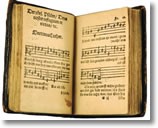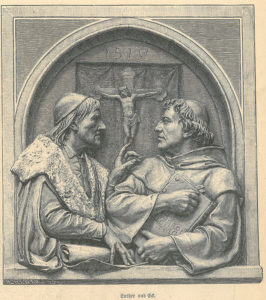by Mr. Jonathan Swett

The day that I had planned to begin preparing this article happened to be October 2, the morning we all awoke to hear the news and learn of the horrific attack and chaos that took place in Las Vegas the prior evening. With “A Mighty Fortress Is Our God” already swirling in my head, a few lines were brought to the forefront, “The old evil foe now means deadly woe” and “Though devils all the world should fill….” Our first emotions in times of tribulation are nearly always of the sinful flesh and of temporal reality in this life. Wouldn’t it be wonderful if there was a hymn that could comfort in tragedy as well as rejoice in thanksgiving; was equally appropriate at a funeral or wedding service; could be sung during any time of the church year; was based on Scripture; could be sung by young and old together, in all Christian worshipping bodies, in all countries of the world? Fortunately, thanks to Martin Luther there exists such a hymn: “A Mighty Fortress Is Our God”!

Perhaps I am in the minority for the choice, but this chorale of Luther’s was used during my wedding service. My lovely bride-to-be processed up the aisle to an extended instrumental introduction which led directly into the congregational singing of the processional hymn in its entirety. And let it be known here that I desire for this hymn to be sung at my funeral service when the Lord calls me to eternal rest in His nearer presence. The beauty of this hymn also extends outward from the seasons of one’s personal life to those of the church year. You may wonder how this could fit, for example, during the Christmas season. Explore stanza two: “Whom God himself elected” (see Luke 1:31-33) and “Ask ye, who is this?” (Does this remind you of a particular beloved Christmas hymn?!—see LSB 370). Although it is not a strict paraphrase, “A Mighty Fortress” is closely related to Psalm 46, which Luther used as a basis for his text. It has over 100 English translations alone, appears in more hymnals than any other hymn in all of Christendom, and is sung boldly by all generations across the world in hundreds of other languages.
The chorale likely first appeared in hymnals of 1528 and 1529; however, its first extant source is Andrew Rauscher’s Erfurt hymnal of 1531. The precise motivation for Luther’s text is unclear, yet evidence exists that it spread quickly and gained notoriety in significant fashion. It was sung at the Diet of Augsburg (1555) and in all the churches of Saxony. Upon their entrance to Weimar following their banishment from Wittenberg in 1547, Philip Melanchton, Justus Jonas, and Kaspar Kreutziger were comforted hearing a young girl singing the hymn on the street. Commonly referred to as the “battle hymn of the Reformation,” it also became the national hymn of Protestant Germany, the hymn of the army of Gustavus Adolphus in 1632 during the Thirty Years’ War in the Battle of Lützen, and a traveling hymn for the Salzburg Emigrants of 1732.
The earliest full English translation of “A Mighty Fortress” appeared in Lyra Davidica in 1708. Thomas Carlyle (1795-1881)—Scottish historian, essayist, moral teacher, and rector—due to his knowledge of Luther and poetic gift provided what is in many respects the best English version. The translation that appears in Lutheran Service Book is a composite taken from the Pennsylvania Lutheran Church Book (1868), prepared by the editorial committee of that book, based on Carlyle’s version and on a version by W. M. Reynolds based on Carlyle’s, which was included in the General Synod’s Collection of 1850.

The tune Ein feste Burg is believed to have been written by Luther and appeared in its first extant source Kirchengesang, mit vil schönen Psalmen vnd Melodey, gantz geendert un gemert (Nürnburg, 1531), and was the same as we know it today (with the exception of one note value). This original ‘rhythmic’ version features the liberal mixture of different metric patterns characteristic of many of the early Reformation chorales which provides them with a distinctive and fast-flowing motion. It is now common for hymnals to also include this text with the ‘isorhythmic’ version of the melody which first appeared in Johann König’s Harmonischer Lieder-Schatz of 1738. Although Johann Sebastian Bach championed this smoothed-out form in which the harmony and melody move in the same rhythmic values, he was not its pioneer evidenced by the existence of earlier examples in the style. J. S. Bach and Felix Mendelssohn used the tune as main thematic material for Cantata BWV 80 and Symphony No. 5, respectively.
W. G. Polack eloquently expresses: “The good this hymn has done, the faith it has inspired, the hearts it has comforted, the influence it has exerted, cannot be measured and will first be revealed to us in eternity, where the saints of God will praise their Lord and redeemer for many blessings, not the least of which will be the privilege of having known and sung this hymn here on earth.”1 When the attacks of the evil one assail us—be they of acts of terror, sudden tragedy, or failing health—as well as in times of thanksgiving, we can trust in the One who is faithful and has promised to be with us always and rejoice with Luther that “Our victory has been won; the Kingdom ours remaineth.” Thanks be to God for this in Christ Jesus!
Jonathan A. Swett is Kantor of Our Savior Evangelical Lutheran Church and School, Hartland, Mich.
1 Polack, W. G. The Handbook to the Lutheran Hymnal. St. Louis: Concordia Publishing House, 1942.
Bibliography:
Eskew, Harry, and Hugh McElrath. Sing with Understanding: An Introduction to Christian Hymnody. Nashville: Church Street Press, 1995.
Precht, Fred. Lutheran Worship: Hymnal Companion. St. Louis: Concordia Publishing House, 1992.
Stulken, Marilyn Kay. Hymnal Companion to the Lutheran Book of Worship. Philadelphia: Fortress Press, 1981.